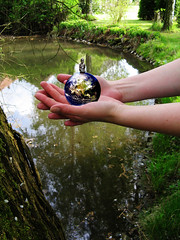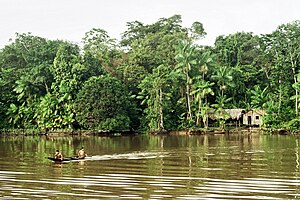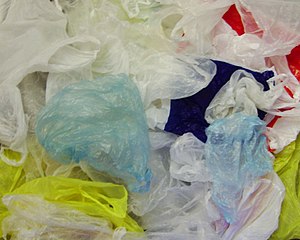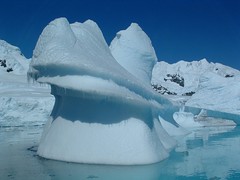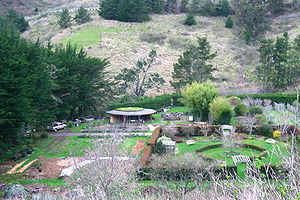 Image by mrehan via Flickr
Image by mrehan via Flickr
By
Glada Lahn
Resource stress, pollution and climate change all threaten to aggravate instability and inequality in the Gulf, but have so far failed to capture the public imagination. Now a wave of grassroots initiatives is trying to change this. Springing up in response to local problems, often employing Islamic narrative and spreading through Facebook, the movement is characteristic of the Gulf's new generation and its rapidly evolving approach to ecology.
"It's growing like crazy" says the effusive Khayra Bundakji of the environmental movement in Saudi Arabia's coastal city of Jeddah. A surprising fact, perhaps, in a country not known for its ecological values. What's more, women are leading the movement. Of the 17 groups Bundakji found active in Jeddah on environmental issues, 15 of them were initiated by women.
Bundakji, a computer science major and internet blogger, founded Faseelah, Effat University's first Islamic environmentalism organization in 2010. She also works with Naqa'a (purity), the brainchild of two nursing students, which calls itself a youth driven "environmental enterprise." Naqa'a's educational campaigns emphasize "the three Rs"-reduce, reuse, recycle-of the western mantra, the Islamic duty of stewardship over the environment, as well as concepts of purity and reining in excessive consumption.
Despite these examples, the environmental movement is still a small world, composed mainly of the educated middle class. Exposure to ecologically conscious societies in the West and efforts in other Gulf cities are the most commonly cited influences feeding the Gulf's environmental movement, according to Bundakji, who lived in the US and Dubai for 11 years.
Environmental campaigns in the United Arab Emirates (UAE) are at least a decade ahead and have been impacted by the large expatriate community (over 80 percent of the population). A former government official, Habiba Al-Marashi, established the Emirates Environmental Group in 1991 and has become a one-woman tour de force in railing against over consumption and engaging the private sector in sustainability drives. The international World Wildlife Fund (WWF) opened its first office in a Gulf State in Abu Dhabi in 2001, where it conducts conservation projects and tracks the heavy environmental footprint of UAE citizens. High-profile events such as the Sharjah Art Biennale, initiated by Sheikh Qasimi whose 2007 theme was ecological art, have also raised awareness in the region.
"People in the West often view these initiatives as either a drop in the ocean in countries which rely on oil exports or as plain hypocrisy because of their high levels of consumption" says Professor Jeremy Bendik-Keymer, a former lecturer in environmental ethics at the American University of Sharjah. But he cautions against cynicism. "In fact, what you see in the Emirates is just an intensified version of the material system we have in the US ... the advantage they have is their 'can do' attitude and the capital to back it up."
While the glamour of green activity in the UAE may have offered inspiration to Jeddah, it was the tragic floods of November 2009 that really kick-started local activism. One group, Muwatana, began as an emergency volunteer relief effort for the victims and has become active in subsequent local environmental improvements such as beach clean-ups-a look at its Facebook page reveals 1,751 members and it has served as an initial network and model for other groups.
"Before the floods, there was interest in the environment but it was not considered a priority" says Dr Majdah Aburas, member on the board of directors of the Saudi Environmental Society (SENS), an organization begun in 2006 under the auspices of Environment Minister, Prince Turki bin Nasser. "After the floods, people became a lot more active-SENS organized a campaign of 900 volunteers from many different [informal] groups to help with the clean-up operation-and there was much more interest in acting to improve their local environment."
SENS is now leading a national cleaning campaign in collaboration with the Mayor of Jeddah and Prince Salman bin Sultan's Charitable Heritage Foundation, which explains the penalties for dumping waste but also regenerates deprived neighborhoods. "Every Thursday, we are in a historical area of Jeddah" says Aburas, herself a renowned specialist in the bio-remediation of crude oil pollution on desert soil. "One of the projects is getting volunteers to redesign a small garden in a neglected, poor area that will both fit with traditional aesthetics and provide a nice recreational space for poor families."
Most volunteers are young people - from the ages of 4 to 30. And yes, SENS abides by Saudi law and custom in separating the male and female volunteers during activities. "This is why we will be successful" she says "because we take into account tradition and social development needs as well as the environment." Al-Marashi is likewise impressed by the volunteering spirit in the UAE. "For example, the recent Clean Up UAE campaign witnessed the participation of 20,000 volunteers across the country who collected 91 tons of waste!" she says.
Greenpeace-style activism this is not. Political status is also ambiguous. Aburas terms groups like Muwatana "voluntary committees" as they do not have status as organizations under Saudi law. Can we even use the terms grassroots or civil society? Dr Chris Davidson, author of Abu Dhabi: Oil and Beyond, thinks not in the case of groups in the UAE, "you will find that they usually have patronage from the rulers and it would be very hard for them to publicize government crimes against the environment...it doesn't help that the press is one of the most controlled in the region."
"We can't speak of a coherent civil society movement in the UAE as such-because of the politics, that is tricky" says Bendik-Keymer, "but we can see three broad areas of environmental action in the UAE: community philanthropy, 'green business' initiatives, and stunningly futuristic engineering projects." Under the first category come groups like EEG and Emirates Diving that organize voluntary beach and reef clean-ups, and social efforts like Adopt-a-Camp-a volunteer group helping to improve sanitary conditions in the South Asian worker camps.
The second is manifest in the media saturation with environmental claims from the business sector which vary from greenwash to seriously innovative conservation projects. The third, like Masdar City (a sustainable city planned for 2025) and the associated solar farm, have an effect on people's minds according to Bendik-Keymer, "they could send a powerful message about the kind of civilization the Emirates aspires to be."
In spite of their comparative newness and less sophisticated PR, the Saudi initiatives benefit from a more investigative press and the much larger indigenous university-aged population. They have steered clear of any conflict with the state but informal conversations reveal disdain for local management of the environment and concerns about the lack of mechanisms for accountability. Nevertheless, all express hope for more support from the national government and senior figures of society in putting this to rights.
Professor Hussain Fouad Sindi, project manager with independent Saudi think tank Al-Aghar, is leading a professional team in drawing up a practical water strategy for the Kingdom. He went on national television last year to criticize both the bureaucracy for mismanaging water and the general public for wasting it. But he stresses, "our King is determined to tackle the issue [of water] no matter what it takes, that I am personally sure of. So, when finished, an executive report of this study will be handed to His Majesty."
Kuwaitis, who have a longer tradition of open political debate and suffered some of the worst effects of oil pollution during the 1990-91 Gulf War, are more outspoken. Last May, 15,000 students were reported to have staged a two-day walk out over heavy industrial emissions in Kuwait's Umm Al-Haiman area, which are thought to be causing cancer and respiratory illnesses. This and a public demonstration by 200 people was organized by the local volunteer environmental protection committee and supported by Kuwait's Greenline Environmental Group - an NGO started in 2001 by journalist Khalid al-Hajeri, who frequently lambasts the government on environmental issues in the national and regional press.
Interest in the environment is most often provoked not by global dialogue on climate change or biodiversity but health and business risks closer to home. As one Saudi scientist put it, "ok, we need to reduce Co2 emissions but we have to put the national interest first ... we should focus on reducing sulphur dioxide and nitrogen dioxide - have you seen satellite pictures of the huge orange cloud over Riyadh? This is causing serious health problems."
The impacts of pollution are increasingly discussed by the Gulf's media. From an American study reported in October estimating some 600 air pollution-related deaths in the UAE in 2007, to the official Iranian announcement in December that around 3,600 people a month die from smog inhalation in Tehran. Poor sewerage treatment also poses a risk to the reputations of richer Gulf countries. In 2009, raw sewage dumped in Dubai's storm drains closed the luxury Jumeira Beach resort. Lake Salwa in Qatar is another example of rapid development outpacing infrastructure. "This is threatening to pollute the already dwindling national water table" warns Doha-based UNESCO project officer Mark Sutcliffe.
Bundakji is a strong believer in the power of grassroots driven movements to promote real change in society towards sustainability. She attended a think tank workshop prior to the Saudi Water and Power Forum (SWPF) last October and says; "I met so many passionate ministers and heads of companies like Philips and GE who would love more attention and time dedicated to these issues. However, I feel that it will take the voluntary leaders to push influential [government] bodies in the direction."
She immediately saw the empowering role SENS could play in coordinating and focusing what she feels is a fragmented and ill-equipped movement. She liked Aburas's reference to SENS as a "tent" for the informal committees. "What would really help us is if SENS could list all the different groups with websites and contact details on one page of its website."
"It is helpful that Facebook is such a big part of our culture, because causes and campaigns spread at an exponential rate through it." However, she warns, "the majority of the initiatives are based on half-baked ideas" not necessarily based on a solid understanding of the local context and ecology. "For instance, many an Earth Day has been celebrated by planting trees that have not been proven to be indigenous to the region. The fall of such initiatives comes when the initiator realizes they don't have enough time to educate themselves on local conservation needs, let alone the masses."
Nationwide education is Aburas' ambition. Her mission is to convert SENS into an independent not for profit company and get the government and some private sector sponsors to sign up to its ten-year strategy aimed at a transition in behavior in the country. "This would be the first national awareness program for sustainable development in the Arab World; it would use many tools but concentrate on schools to not only raise environmental understanding but change habits in the country."
As a way forward for fledgling environmental groups where legal political status is not an option, the idea of social enterprise is catching on. Many are seeking company, rather than charity status. This fits with both the religious support for voluntary philanthropic work and government support for private sector-led development and avoids the politically antagonistic field of the lobby group or even the NGO.
First published: Wednesday 02 February 2011
http://www.majalla.com/en/ideas/article249606.ece
Article Source:
http://EzineArticles.com/?expert=Glada_Lahn
http://EzineArticles.com/?The-New-Wave-of-Environmentalism-in-the-Gulf&id=5851385
 Image via WikipediaBy Semele Xerri
Image via WikipediaBy Semele Xerri
